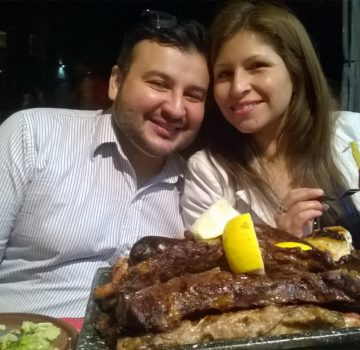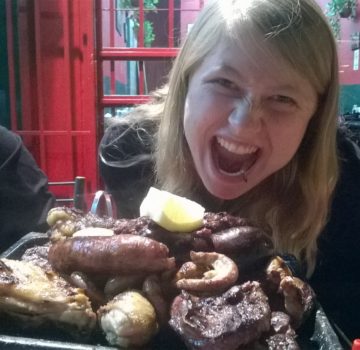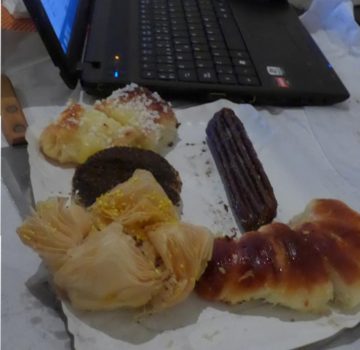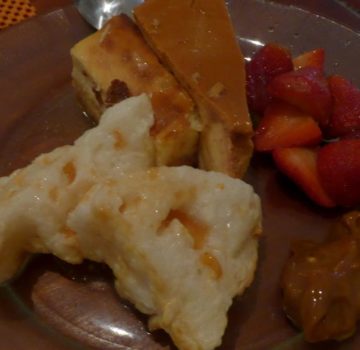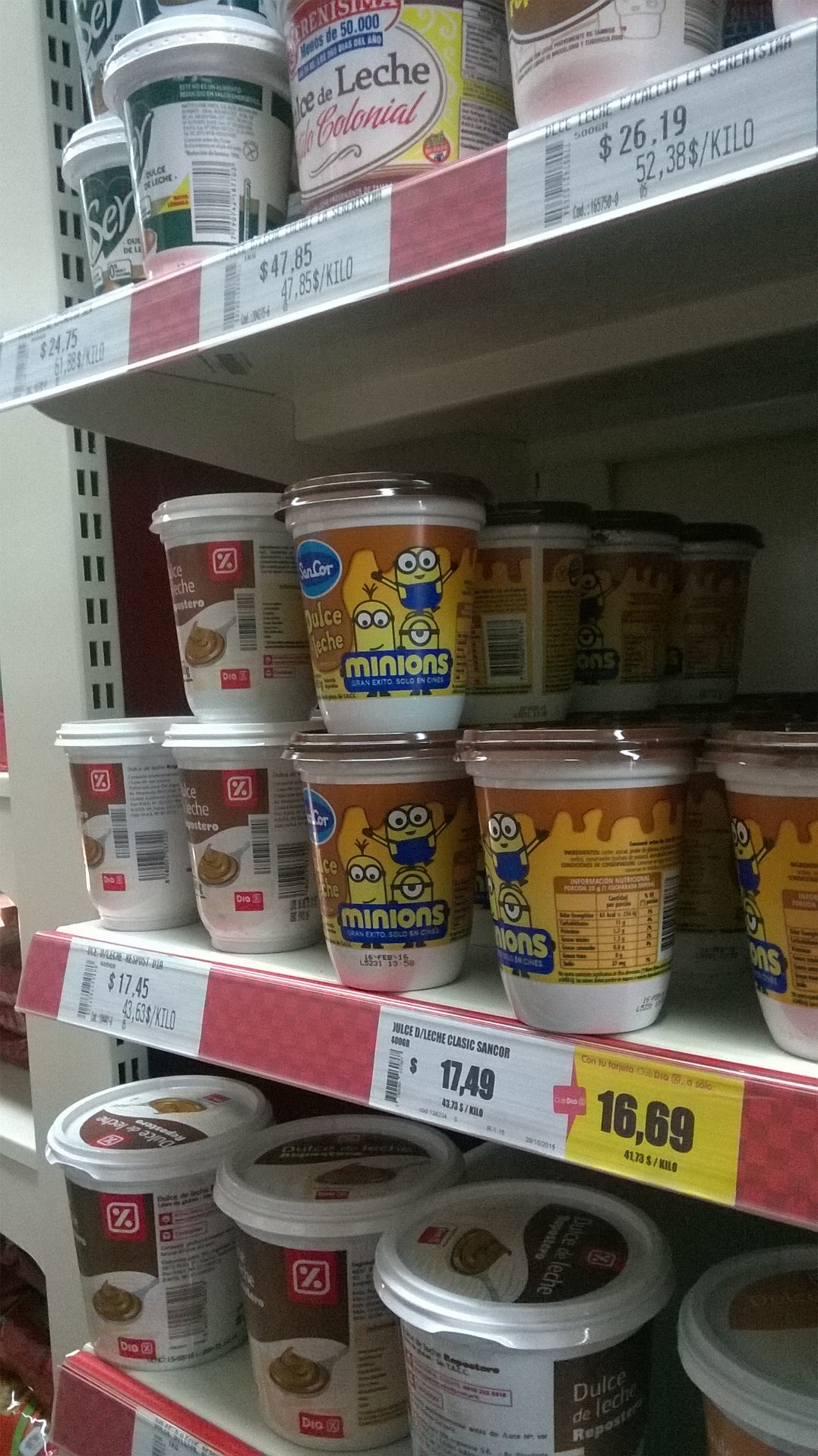
Essen
Dezember 5, 2015
Essen.
Mein Lieblingsthema.
Also von vorne. Da hier viel Rind gezuechtet wird, ist es guenstig und wird sehr viel gegessen. Und ja, hier ist es fast noch schwieriger VegetarierIn zu sein, als in den USA.
Es gibt also viele Fleischspezialitaeten, zum Beispiel:
Food: my favorit thing in the world!
Good to know: Beef is the most common meat – cheap but still good quality – since there is so much cattle bred here. As worldwide known there are many specialities , mostly meat such as:
Parrilla:
Es bedeutet Grill. Somit ist fast alles „asado a la parrilla“ auf dem Grill geroestet, also gegrillt.Das ist dementsprechend keine Spezialitaet, sondern alles Folgende in irgendeiner Form.
It means grill or barbecue. „asado a la parilla“ would be roasted/cooked on the grill, so: to barbecue. Which means it is not a specialty – just the way how most specialties are prepared here.
Asado:
Das heisst einfach nur Braten/geschmort/geroestet und ist vor allem Schwein und Rind hier.
Means either to braise/roast or the roast. Usually used are beef and pork.
Tira de Asado:
Das heisst wortwoertlich Streifen vom Braten und ist gegrillte Quer-/Hochrippe (Rind), ein Streifen Fleisch, der relativ viel Fett enthaelt und den man in Deutschland eigentlich gar nicht verwendet, soweit ich weiss. Ausser fuer Saucen etc.
It translates more or less: Strip of the roast. What it really is is the a long strip cut from the ends the ripcage. A part that in germany and I think in the US isn’t really used either. Besides for sauce, broth, stock…
Chorizo:
Original aus Spanien/Portugal Paprikawuerstchen aus Schwein mit viel Knoblauch. Hier in Argentinien heisst das mehr so Bratwurst, enthaelt aber trotzdem auch mal Paprika und Gewuerze sowieso.
Originally from Spain/Portugal are those sausages with bellpepper and garlic usually made of pork. Here in Argentina though it basically means „Bratwurst“ so simply fried/grilled sausage. They don’t necessarily contain bellpepper but that doesn’t mean they don’t use many condiments.
Lomo:
Lende vom Rind. Somit Rinderfilet. Es wird hier oft als Steak gegrillt, so ist das meistens gemeint. Kann aber natuerlich auch geraeucherte Wurst sein.
Tenderloin (beef). Kind of Steak. It is often grilled thick round medallions/cotelettes sometimes wrapped in bacon. But of course it can also be meant as smoked cold cuts.
Morcilla:
Blutwurst. Wird hier sehr gerne so wie alles andere gegrillt.
Bloodsausages. Grilled like everything else.
Asaduras:
Innereien sind fuer die Leute sehr normal zu essen. Vor allem sehe ich hier Niere, Leber und fuer Deutschland eher untypisch: Magen.
Innards. A very normal thing to eat here, people aren’t as afraid of them as in germany or especially the USA. Most of all liver, kidney and for germany very untipical: stomach.
Milanesas:
Kein Bestandteil des Grillens. Es sind schlichtweg Schnitzel, allerdings oft gebacken (im Ofen) statt in der Pfanne gebraten oder frittiert und meistens Haehnchen, Kalb ist es in Deutschland original (mittlerweile oft Rind oder Schwein). Dabei wird hier Kalb glaube ich eigentlich gar nicht verwendet.
That’s what even in the USA is called Schnitzel. So it’s not grilled for once. It’s a little bit different though. In Germany Schnitzel is breaded (flour, egg, breadcrumbs) veal. Veal is (I think) never used here. The original is pan-fried. Nowadays pork and beef are used, too and it is often deep-fried because it’s quicker. Here it is usually chicken and I saw it baked in the oven more than anything else.
Empanadas:
Teigtaschen, entweder frittiert oder wie original gebacken, mit Eigelb bestrichen. Uebliche Fuellungen sind Carne, (womit eigentlich fast immer nur Rindfleisch gemeint ist), gehacktes gekochtes Ei und Paprika sowie Kaese und Schinken sowie Kaese und Zwiebel sowie Kaese und Mais sowie Gemuese sowie Haehnchen. Wobei die drei vegetarischen Varianten selbstverstaendlich eher selten zu haben sind.
Stuffed dough pockets. Or so. Usually brushed with eggwash and baked in the oven but sometimes deep-fried as well. The most common varieties are Carne (which means meat translated but mostly refers to beef) with chopped boiled eggs and bell-pepper; ham and cheese; onion and cheese; corn and cheese; vegetables or chicken. Of course you won’t always find those vegetarian kinds.
Pizza:
Ist hier fast schon Chicago-Style! Oft unglaublich dick, fast nur aus Kaese und Teig bestehend und dann eben vielleicht noch mit entsprechendem Fleisch oder Gemuese dazwischen ausgestattet.
Reminds me of Chicago deep-dish more than Italian. It’s a really thick dough and Pizza mostly cheese and a little bit of filling in between.
Puchero:
Uebersetzt: Eintopf. Wie in jedem Land enthaelt das arme Leute Essen namens Eintopf einfach alles, was es gab. Hier vor allem Kuerbis, Kartoffel, Suesskartoffel, alles moegliche vom Rind, Paprika, Karotten, Mangold und Eier. Je nachdem variiert der natuerlich auch nach Region, wie ueblich.
Translated: Stew. Just like in every other country it used to be poor people’s food with everything that grew around here and meat. Mostly used for this one are squash, sweet potatoes, beef of course, bell-peppers, carrots, swiss chard and boiled eggs. Of course there are plenty of variations.
Das ist nicht nur Luis und mit seines Partners (Danny) Schwester sondern auch Tira de Asado ganz vorne auf diesem schlechten Handybild zu sehen.
This isn’t only my friend Luis and his boyfriend’s sister but also Tira de Asado right in front to see in this very badly taken picture with my incredibly stupid phone.
Hier die bessere Seite des typischen Parrilla. Ganz vorne links einfach Haehnchen, quer ueber allem liegend Chorizo. Das Ohrfoermige oben drauf rechts ist Magen. Hinten rechts Blutwuerstchen und ganz schlecht zu erkennen vorne ganz rechts Leber
Typical Parrilla: right in front on ther very left just chicken. The sausage on top is Chorizo, the very dark little sausage in the back on the right is that bloodsausage. That thing that looks like an ear on top on the right is stomach and on the very right in front hardly recognizable: liver.
Fruehstueck gibts auch und somit ueberall Panaderias und Confiterias.
Es ist mehr so ueblich hier einen grossen Kaffee mit sehr viel Milch und Zucker zu fruehstuecken und dazu Weissbrot, Cracker oder Medialunas (Halbmonde, kleine Buttercroissants) in den Kaffee zu tauchen oder gleich reinzulegen. Ausserdem gibt es noch etliche weitere sehr leckere Konditoreiprodukte, genannt „facturas“ (Teilchen im Deutschen), zu denen auch „churros“ zaehlen, die hier allerdings gebacken werden, nicht frittiert. Ausserdem sind die relativ salzig und werden nur mit wenig Zucker bestreut. Ich esse sie sehr gerne in allen Varianten. Sehr gut auch mit Schokoladenueberzug und gefuellt mit Dulce de leche.
Breakfast here is very different from the USA or Germany and there are plenty of Panaderias (Bakeries) and Confiterias (don’t exist in the USA, little shops for tarts, pies, chocolates, all kinds of cookies and dough things, sweet and savory. Like an extended bakery).
Breakfast isn’t really a thing here and neither comparable with the huge German type of breakfast with juice, cold cuts a lot of cheeses, fruits, eggs, grapefruit, rolls and different types of bread, butter, curd, jam and so on nor the hot American one. It’s rather french in my experience and maybe similar in Portugal, Spain, Italy…
I don’t know exactly but here you just have a really huge strong coffee with a lot of milk and sugar. Just like with everything they have white bread, like soft baguette or cracker or Medialunas (half-moon is the name. Tiny delicious butter-croissants). They dip all of it into the coffee or sometimes just drown it in there.
Besides that there are plenty of other delicious things to buy in those confiterias, called „facturas“. The probaly most famous ones are Churros. Here again not deep-fried but baked in the oven and I think the dough is different here, too. They are slightly salty and don’t contain a lot of sugar. I love them very much and could eat them every day. Mostly you’ll get them plain with a little sugar on top, filled with Dulce de Leche or filled with Dulce de Leche and covered in chocolate.
Ein weiteres schreckliches Handybild. Klar zu erkennen das mit Dulce de Leche gefuellte Schokoladen-Churro hinten rechts. Vorne rechts ein medialuna de manteca. Also ein Buttercroissants, Medialunas sind deutlich weniger suess und kleiner und heller. Hinten links ein Pan dulce (suesses Broetchen) mit Pudding und Hagelzucker und vorne links ein Hojaldre con membrillo (Blaetterteig, aber frittiert mit Quittenfuellung).
Another terrible phonepic for you. In the back on the right a chocolate churro stuffed with dulce de leche. in front on the right a medialuna de manteca, a buttercroissant though medialunas are less sweet and thinner and lighter of color. In the back on the left a pan dulce (sweet roll) with pudding and sugar on top and in front on the left a deep-fried puff-pastry filled with quince.
Desserts und Dulce de leche:
Ich habe hier noch nicht einer Person getroffen, Tourist oder Einwohner, die nicht Dulce de leche, die Suesse der Milch, liebt. Es ist genaugenommen nur Milch und Zucker, evtl. Vanille, die ueber Stunden bei niedrige Hitze und staendigem Ruehren heruntergekocht wird. Dulce de leche dient als alles, Brotaufstrich, Eis, Sauce, Fuellung, Geschmacksrichtung. Sehr viele facturas (Teilchen) sind damit gefuellt. Bevor ich es vergesse zu erwaehnen, es wird auch ganz viel mit Quitte gearbeitet, nur, dass die hier schoener heisst: „membrillo“.
Am wichtigsten jedoch ist Dulce de leche im Zusammenhang mit Flan zu erwaehnen, ein pochierter Eierkuchen, wie Creme Moulee, mehr Eier und Milch statt Sahne. Eigentlich fast genau wie Creme Caramel.
Also Milch, viele Eier, Zucker, Vanille und dann einfach mixen, passieren, in ofenfeste Form geben, in Wasserbad bei ca. 180 Grad backen bis es wackelt, aber nicht mehr fliesst. Hihi. Abkuehlen lassen und stuerzen. Ublicherweise kocht man hier eben Zucker (Caramel) und giesst diesen zunaechst in die Flanform, sodass die Sauce sich ueber den Flan zieht, beim Stuerzen. Und das kriegt man hier fast ueberall zu essen, eben vor allem mit Dulce de leche.
Ebenso ueblich als Desserts sind „Budin de pan“ Brotpudding. Also Flan mit den alten Brot aufgeweicht und durchaus gerne auch mit Fruechten. Ebenfalls pochiert. „Isla flotante con sabayon“ schwebende Insel mit Sabyone. Das ist eigentlich ebenfalls pochiertes geschlagenes Eiweiss mit Zucker, auch oft mit Caramel drunter.
I am not lying when I say that I haven’t met any person yet, tourist or inhabitant – who doesn’t love Dulce de Leche, the sweet(ness) of milk. It is only milk, sugar, vanilla and nothing else. Those things are cooked down over hours on low heat. It needs to be watched and stirred. In the end you have a caramel-like golden-brownish cream. It is very delicious and a lot smoother than caramel/toffee. Here it is used for everything, as filling as sauce as icecream on bread and as flavor for many things. As mentioned many facturas are stuffed with it, too. Just as chocolate or tarts. Also seen often here is quince but it’s got a prettier name: membrillo.
You can’t talk about Dulce de Leche without mentioning Flan though. Flan is a poached eggpie very similar to creme moulee (more eggs, milk instead of cream) and basically the same as creme caramel.
So I kind of said it already: Milk, many eggs, sugar, vanilla all stirred and strained. Poured into your favorite ovenware and baked in a waterbath at 350 F until it wobbels but isn’t liquid anymore. Let cool down and turn over. Usually you cook caramel first and pour some into your ovenware first. That way the caramel will run over your Flan. This delicious desert has to be eaten with Dulce de Leche!
Just as common is „Budin de pan“ breadpudding. It is like breadpudding. Haha. It exists to use up all the old and dry white bread leftovers. Those are mixed with milk, eggs, sugar, vanilla and often fruits. Poached the same way and turned over. „Isla flotante con sabayon“ is the floating island with Sabayone. It is beaten eggwhites with sugar. Nothing more. Also poached. Sabayon consists of only yolks beaten in a bowl over water steam with sugar, flavors if wanted and white whine. it becomes a fluffy airy delicious sauce which goes great with the other part of the egg.
Also noch ein furchtbares Bild, diesmal mit Erdbeeren. Und links daneben Flan, der fast genauso aussieht wie der Kaesekuchen nochmal links daneben. Der weisse Haufen ist natuerlich Isla Flotante und vorne rechts das Zeuch ist natuerlich Dulce de Leche.
In this third very terrible picture you see strawberries. And also Flan right in the middle next to them. It looks nearly like the cheesecake on the left of the Flan. The white pile is the Isla Flotante but without Sabayon just with caramel. And the cream on the right is Dulce de Leche of course!
